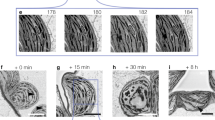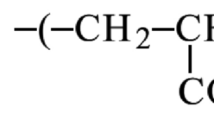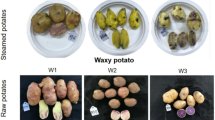Abstract
Peat and Whelan1 have already described the chemical changes occurring during the aerobic photodegradation of amylose and amylopectin when dispersed in water. More recently, Whelan and Baker2 have extended these investigations to commercial whole starches in the dry state (note: such starches still contain 15–20 per cent of bound water). During the aerobic degradation of whole starches, morphological changes were observed which promised to throw some light upon the gross and fine structural organisation of the raw starch granule. When potato starch irradiated in ultra-violet light of 3660 A. was mounted in a non-aqueous medium such as anisole (refractive index 1.51), microscopic examination showed that the majority of the granules still retained their birefringence. If examined at room temperature, in water, iodine solution or other aqueous reagents, the granules swelled almost immediately and lost their birefringence. These changes were accompanied by the separation of clearly defined surface membranes and by solubilization of the contents of the granule, which diffused slowly into the surrounding medium. Swelling appeared to be due in part to osmosis, since a proportion of the granules burst, leaving the peripheral membrane as a shrunken residue in which a clear rent, through which the solubilized contents had escaped, was always demonstrable. Also, on irrigation with ethanol, the process was reversed and the swollen granules contracted.
This is a preview of subscription content, access via your institution
Access options
Subscribe to this journal
Receive 51 print issues and online access
$199.00 per year
only $3.90 per issue
Buy this article
- Purchase on SpringerLink
- Instant access to full article PDF
Prices may be subject to local taxes which are calculated during checkout
Similar content being viewed by others
References
Peat, S., and Whelan, W. J., J. Soc. Dyers and Colourists (in the press).
Whelan, W. J., and Baker, F., 1st International Congress of Biochemistry, Cambridge, 1949. Abstracts, p. 511.
Badenhuizen, N. P., Rec. Trav. botan. néerlandais, 35, 561 (1938).
Alsberg, C. L., Plant Physiol., 13, 295 (1938).
Haller, R., Helv. Chim. Acta, 23, 596 (1940).
Frey-Wyssling, A., “Submicroscopic Morphology of Protoplasm and its Derivatives”, 223 (Elsevier, N.Y., 1948).
Baker, F., Nasr, H., and Morrice, F., J. Gen. Microbiol., 3, (No. 1), Proc. xv (1948).
Author information
Authors and Affiliations
Rights and permissions
About this article
Cite this article
BAKER, F., WHELAN, W. Some Morphological Features Accompanying the Aerobic Photodegradation of Whole Potato Starch. Nature 165, 449–450 (1950). https://doi.org/10.1038/165449b0
Issue date:
DOI: https://doi.org/10.1038/165449b0



